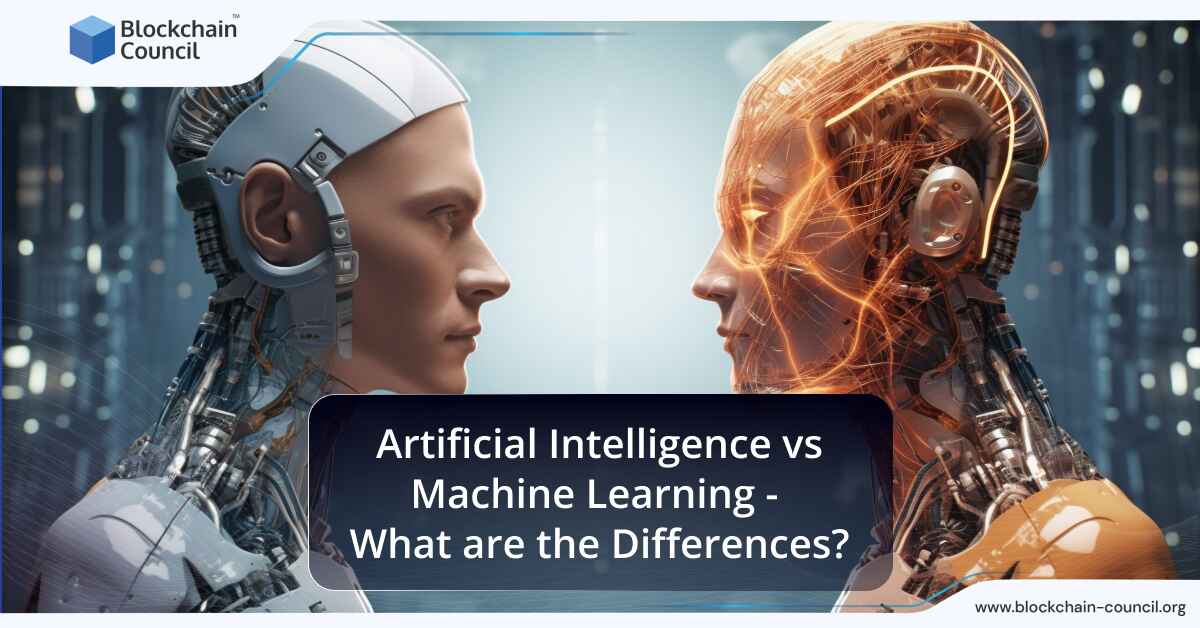
- Blockchain Council
- May 18, 2024
Summary
- AI and ML have distinct roles; AI includes ML but goes beyond it with robotics and natural language processing.
- ML is focused on learning from data, while AI encompasses learning, reasoning, and problem-solving.
- AI aims for human-like intelligence, while ML works with specific data patterns.
- AI is used in autonomous vehicles, while ML drives recommendation systems and fraud detection.
- ML adapts by learning from new data, while AI may adapt through a broader set of methods.
- Historical perspective: AI originated in the 1950s, while ML emerged around the 1980s in response to rule-based AI limitations.
- Core concepts: AI mimics human intelligence using Symbolic AI and Neural Networks; ML focuses on pattern recognition.
- Scope and application: AI covers NLP, robotics, and more; ML is integral in finance, healthcare, and predictive analytics.
- Data dependency: AI operates independently of specific data formats; ML relies on clean, reliable data and benefits from big data.
- Learning mechanisms: AI follows predefined rules and adaptive learning; ML uses algorithms like decision trees, K-NN, and neural networks.
Introduction
Artificial Intelligence (AI) and Machine Learning (ML) often overlap but have distinct roles in the realm of technology. AI encompasses ML but goes beyond it, including robotics, natural language processing, and more. ML is all about learning from data, while AI encompasses learning, reasoning, and problem-solving. AI aims for human-like intelligence, while ML is more specific, working with data patterns. AI finds its place in autonomous vehicles, while ML drives recommendation systems, fraud detection, and more. ML adapts by learning from new data, whereas AI may adapt through a broader set of methods.
Understanding these distinctions is pivotal in both professional and academic contexts. AI’s scope encompasses natural language processing, robotics, and more, making it a versatile field. On the other hand, ML hones in on data analysis and predictive modeling, integral in numerous industries like finance and healthcare. Discerning these differences is vital for individuals, businesses, and industries to harness their capabilities effectively.
In this article, we will discuss the key differences between artificial intelligence and machine learning.
Historical Perspective
Origins of AI
In understanding the differences between artificial intelligence (AI) and machine learning, it’s essential to explore their historical roots. AI, the broader concept, originated in the 1950s, with the idea of creating machines capable of human-like intelligence. Early AI research was centered around rule-based systems, aiming to replicate human thinking processes. The “Dartmouth Workshop” in 1956 marked the formal birth of AI as a field, where pioneers like John McCarthy laid its foundations.
Evolution of Machine Learning
Machine learning, on the other hand, is a subset of AI that emerged more recently, around the 1980s. It evolved as a response to the limitations of rule-based AI systems and the need for data-driven approaches. The development of machine learning was significantly influenced by advancements in computing power and data availability. Key milestones, like the introduction of neural networks and the “data first” approach, have driven ML’s evolution.
Also Read- Top 5 Artificial Intelligence (AI) Crypto Coins
Core Concepts
AI: Mimicking Human Intelligence
Artificial Intelligence, or AI, is the realm of computer science that strives to replicate human intelligence. In AI, machines aim to mimic human thought processes, like reasoning and problem-solving. Two fundamental approaches in AI are Symbolic AI and Neural Networks. Symbolic AI, often referred to as “classical AI,” relies on logic and rules to emulate human reasoning. It deals with explicit symbols and formal knowledge representations, making logical deductions and problem-solving its core strengths. Symbolic AI is rule-based and widely used in expert systems. On the other hand, Neural Networks are inspired by the human brain’s structure. These systems use interconnected nodes to process information, allowing machines to learn from data and adapt over time. Deep Learning, a subset of Neural Networks, has revolutionized image and speech recognition.
Machine Learning: Pattern Recognition
- Machine Learning is a subset of AI that focuses on pattern recognition, enabling computers to learn from data and make predictions. It includes various learning techniques, such as Supervised Learning, Unsupervised Learning, and Reinforcement Learning.
- In supervised learning, algorithms are trained on labeled data, learning to map inputs to desired outputs. The algorithm learns to make predictions by comparing its output to the correct answers in the training set. This method is widely used in tasks like image classification and language translation.
- Unsupervised Learning involves training models on unlabeled data to find hidden patterns or structures within the data. Clustering and dimensionality reduction are common tasks in unsupervised learning. It’s particularly useful for tasks such as customer segmentation and anomaly detection.
- Reinforcement Learning teaches machines through interaction with an environment. The model receives feedback in the form of rewards or penalties, allowing it to make informed decisions. It’s pivotal in training autonomous systems and game-playing algorithms.
Also Read- Looking For A High-Paying Artificial Intelligence Job?
Scope and Application
| Category | AI Applications | Machine Learning Applications |
| Scope | AI encompasses a wide range of applications that simulate human intelligence and decision-making. | Machine Learning is a subset of AI, focused on developing algorithms that allow computers to learn from and make predictions or decisions based on data. |
| Natural Language Processing | AI is extensively used for NLP tasks like language translation, sentiment analysis, chatbots, and speech recognition. | Machine Learning algorithms are employed in NLP for tasks like text classification, named entity recognition, and language modeling. |
| Computer Vision | AI applications in computer vision include image recognition, object detection, facial recognition, and autonomous driving. | Machine Learning plays a crucial role in image recognition tasks, enabling computers to identify and classify objects within images. |
| Robotics | AI-driven robots use perception, learning, and decision-making to perform tasks, such as manufacturing, healthcare, and autonomous drones. | Machine Learning can be applied in robotics to improve control systems, path planning, and object manipulation. |
| Predictive Analytics | AI and Machine Learning are both used for predictive analytics to forecast future trends, behaviors, and outcomes, benefiting various industries like finance and healthcare. | Machine Learning techniques are at the core of predictive analytics, building models for making predictions based on historical data. |
| Image Recognition | AI, particularly computer vision, plays a significant role in image recognition for tasks like identifying objects, faces, and scenes. | Machine Learning models are applied for image recognition to make sense of image data and classify objects within images. |
| Recommendation Systems | AI is used to create recommendation systems in e-commerce, streaming services, and content recommendation, helping users discover relevant products or content. | Machine Learning is fundamental to recommendation systems, as they rely on algorithms that learn user preferences and make personalized recommendations. |
Data Dependency
| Aspect | AI and Data | Machine Learning and Data |
| Data Independence | Data independence refers to the ability of AI systems to operate without being tightly coupled to specific data formats or sources. This enables more flexible and scalable AI solutions. | ML algorithms require access to clean, reliable data. Data independence ensures that ML models are not influenced by specific data sources or changes. |
| Big Data Impact | AI can leverage big data to improve predictions and insights. Handling large datasets efficiently is a critical aspect of AI. | Machine learning benefits from big data by training on extensive datasets, but it also requires robust infrastructure to process and analyze this data effectively. |
| Data-Centric Approach | AI often follows a data-centric approach, focusing on collecting and utilizing high-quality data to enhance model performance. | Machine learning also adopts a data-centric approach, emphasizing the importance of data quality, relevance, and feature engineering for model success. |
| Data Preprocessing | Data preprocessing is crucial in AI to clean, normalize, and prepare data for model training. It helps ensure data quality and model accuracy. | ML models require extensive data preprocessing to handle missing values, outliers, and other data issues, making data preprocessing a fundamental step in the ML pipeline. |
Also Read- What Is Testnet?
Learning Mechanisms
AI Learning
- AI’s learning often relies on predefined rules and conditions to make decisions, giving it a deterministic nature. These rules are created by human experts and guide AI systems in their decision-making processes. It’s a structured approach that ensures a specific set of responses to known scenarios.
- In contrast, AI can also employ adaptive learning. It uses algorithms that enable the system to adjust its behavior based on the data it encounters. This learning mechanism allows AI to evolve over time and adapt to new information. It is more flexible and capable of handling unforeseen situations.
Machine Learning Algorithms
- Decision trees are a popular ML algorithm for classification and regression tasks. They work by creating a tree-like structure of decisions based on input data. Each node in the tree represents a decision, making it a highly interpretable algorithm.
- K-Nearest Neighbors, or K-NN, is a simple yet effective algorithm. For example, in a recommendation system, K-NN can suggest products by identifying items purchased by users with similar preferences. K-NN is straightforward and easy to understand, but it may struggle with high-dimensional data.
- Neural networks are at the forefront of ML. They mimic the structure and function of the human brain, consisting of interconnected layers of artificial neurons. Neural networks are exceptionally powerful for complex tasks like image recognition and natural language processing.
Also Read- Top 7 AI Certificates Programs To Boost Your Career In 2024
Human Involvement
AI and Human Intervention
In AI, Human-in-the-Loop systems seamlessly blend human intelligence with machine capabilities. This synergy enables AI to tackle complex tasks beyond pure automation. Human-in-the-Loop AI systems are perfect for tasks where AI may struggle, like image recognition or content moderation, bridging the AI-human gap. Expert Systems, another facet of AI, replicate human expertise in specific domains. They rely on knowledge bases created and maintained by human experts. These systems use rule-based reasoning to make decisions. They’re like a virtual consultant, providing solutions to problems within their expertise.
Expert Systems can’t learn and adapt as ML models do, but they excel when precise, predefined knowledge is required.
Machine Learning and Human Guidance
Machine Learning necessitates data for training models. Collecting this data is a fundamental phase, often requiring human intervention. Humans curate and label data, making it comprehensible for machines. Their decisions influence model performance and bias. After initial training, ML models may require fine-tuning. Human expertise comes into play to adjust model parameters, optimize performance, and rectify errors.
Fine-tuning ensures the model aligns with real-world conditions, a process that demands human intuition and domain knowledge. It’s a critical step in customizing models to specific tasks, making ML adaptable and efficient.
The Symbiotic Relationship
| Aspect | How AI Enhances Machine Learning | Machine Learning’s Contribution to AI Advancements |
| Data Processing and Analysis | AI algorithms enable faster and more efficient data processing, enhancing ML models’ ability to learn and make predictions. | Machine Learning algorithms power AI systems by providing the foundational tools for pattern recognition, classification, and prediction. |
| Automation and Decision-Making | AI integrates machine learning models to automate decision-making processes, leading to more intelligent and autonomous systems. | Machine Learning helps AI systems adapt and improve through continuous learning from data, making them more capable of making informed decisions. |
| Natural Language Understanding and Generation | AI utilizes ML techniques to understand and generate human language, improving communication between humans and machines. | Machine Learning advances AI by developing language models that can interpret and generate human language, making AI systems more conversational and context-aware. |
Also Read- How Does A Mainnet Work? Explained
Scalability and Complexity
AI Scalability
Artificial Intelligence (AI) grapples with inherent scalability challenges, often stemming from its complex nature. AI systems demand significant computational resources as they process vast datasets and perform intricate tasks. AI systems, particularly deep learning models, require extensive training with enormous datasets. This training process demands high-performance computing resources, including powerful GPUs and TPUs. The challenge lies in efficiently scaling up these resources to handle increasingly complex AI models, which can lead to exorbitant costs.
To overcome scalability challenges, many organizations turn to Cloud AI Services. Cloud platforms offer scalable infrastructure and services tailored to AI needs. Leveraging cloud resources allows for on-demand scaling, reducing the burden of provisioning and managing hardware. Cloud AI services provide access to powerful AI frameworks, pre-trained models, and tools, simplifying the development and deployment of AI applications.
Machine Learning Scalability
Machine Learning (ML), a subset of AI, addresses scalability differently. While it shares some challenges with AI, ML primarily focuses on training models efficiently. Distributed computing plays a pivotal role in addressing ML scalability. By distributing the training process across multiple machines or nodes, ML models can be trained faster and handle more extensive datasets. Distributed ML frameworks like TensorFlow and Apache Spark enable developers to parallelize the training process, making it feasible to scale ML applications. The second aspect of ML scalability lies in the development of scalable ML algorithms. Unlike deep learning models in AI, ML algorithms are designed to be resource-efficient. They aim to provide accurate results without requiring extensive computational resources.
Developers work on creating algorithms that are efficient in terms of time and space complexity. These algorithms are designed to perform well on a variety of hardware configurations, from modest setups to high-performance clusters.
Conclusion
To begin, let’s unravel the intricacies of artificial intelligence (AI) and machine learning (ML). AI encompasses the broader concept of creating machines or systems that can mimic human intelligence. It involves tasks such as problem-solving, understanding natural language, and making decisions, all of which are executed by computer programs. The key distinction lies in the autonomy of decision-making. AI systems are designed to act intelligently without human intervention, using predefined rules and logic. In contrast, ML systems continuously refine their decision-making abilities based on the data they process.
The relationship between AI and ML is dynamic and symbiotic. As technology advances, AI improves ML by providing advanced tools and data-processing capabilities. ML, in return, enriches AI with its ability to enhance decision-making processes through data analysis. Moreover, the technology landscape is in a state of constant evolution. AI keeps progressing to mimic human cognition better, while ML evolves by adapting and improving algorithms. Understanding the nuances of AI and ML is crucial as we navigate this exciting technological landscape.
Frequently Asked Questions
What is Artificial Intelligence?
- Artificial Intelligence (AI) is a field of computer science.
- It focuses on creating machines or systems that can mimic human intelligence.
- AI involves tasks such as problem-solving, natural language understanding, and decision-making.
- AI systems can act intelligently without constant human intervention.
- It aims to replicate human-like cognitive functions using predefined rules and logic.
What is Machine Learning?
- Machine Learning (ML) is a subset of AI.
- It specifically deals with the ability of computers to learn from data and improve over time.
- ML enables computers to make predictions or decisions based on patterns identified in the data.
- It includes various learning techniques such as supervised learning, unsupervised learning, and reinforcement learning.
- ML algorithms adapt by learning from new data and can handle tasks like image classification and language translation.
What are the differences between AI and ML?
- AI encompasses a broader concept, including ML, robotics, and natural language processing.
- ML focuses specifically on learning from data and improving performance over time.
- AI aims for human-like intelligence, while ML works with specific data patterns.
- AI can adapt through a broader set of methods, while ML adapts by learning from new data.
- AI is used in autonomous vehicles, while ML is applied in recommendation systems, fraud detection, and more.
Is AI and ML the same?
- No, AI (Artificial Intelligence) and ML (Machine Learning) are not the same.
- AI is a broader field that includes ML as one of its components.
- AI encompasses tasks beyond learning from data, such as natural language processing and robotics.
- ML specifically focuses on the ability of computers to learn and improve from experience.
- While related, AI and ML have distinct roles and applications in the realm of technology.





































































 Guides
Guides News
News Blockchain
Blockchain Cryptocurrency
& Digital Assets
Cryptocurrency
& Digital Assets Web3
Web3 Metaverse & NFTs
Metaverse & NFTs
